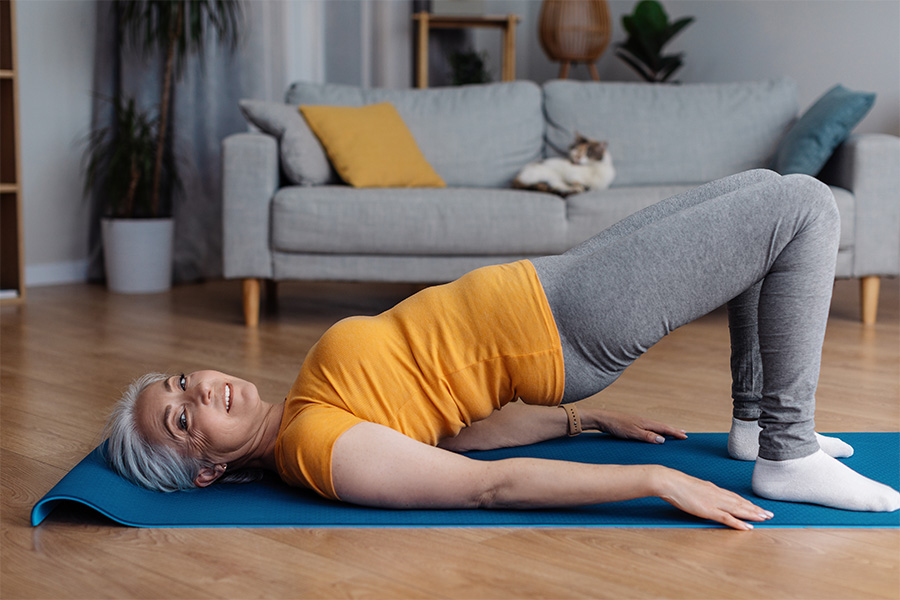You don’t think twice about working out to keep your arms, legs, abs, or glutes in good shape, but what about your pelvic floor? Although you can’t see your pelvic floor muscles like the muscles in other parts of your body, keeping them strong and healthy is important.
The pelvic floor is a bowl-shaped structure containing a group of muscles that support the bladder and bowel. The pelvic floor also plays a role in sexual function.
Sometimes, pelvic floor muscles become weakened because of pregnancy, obesity, or previous surgeries. This can cause a range of conditions, from loss of bladder or bowel control to organ prolapse — when one or more of the pelvic organs drop or press into or out of the vagina. And although issues occur more often with women as they age, it’s not necessarily a normal part of aging.
Luckily, simple lifestyle tips help keep your pelvic floor strong and healthy.
1. Practice Pilates or yoga.
These activities, along with other core-strengthening exercises, strengthen your pelvic floor muscles and have been shown to help some women with urinary incontinence.
Incorporate Pilates or yoga into your weekly routine with free classes through the VEBA Resource Center (VRC). Join virtually from the comfort of your home or alongside fellow members at a VRC location for motivation and fun.
2. Maintain a healthy body weight.
A healthy body weight reduces excess pressure on your pelvic floor muscles and organs. It can also reduce the risk of chronic diseases, such as diabetes and high blood pressure, which may also play a role in pelvic floor disorders, such as urinary incontinence.
3. Do Kegel exercises.
Kegels are a simple exercise that can help strengthen your pelvic floor muscles. To start:
- Make sure your bladder is empty.
- Using the muscles you’d use to stop urine midstream, tighten and hold the muscles for 10 seconds.
- Release and relax for the same amount of time.
- Repeat tightening, holding, and releasing for up to 10 repetitions.
4. Don’t hold your urine.
It’s normal to be able to hold your urine for two to three hours. However, holding it for longer periods could lead to urinary issues later in life and increase your risk of urinary tract infections.
5. Don’t sit for long periods on the toilet straining or pushing.
This can lead to unhealthy bowel movements and urination behaviors. It also increases your risk of organ prolapse because of the pressure it places on the pelvic floor organs and muscles. If you’re experiencing constipation, increase fiber in your diet or take a fiber supplement to soften the stool.
6. Learn proper lifting techniques and avoid repetitive or heavy lifting.
Lifting heavy objects can be a risk factor for pelvic floor disorders because it puts pressure on the pelvic muscles. If you must lift something heavy, maintain a good lifting posture and ask for help when needed.
7. Cut back on caffeine, chocolate, citrus, alcohol, and carbonated drinks.
These beverages can irritate the bladder and cause urinary frequency, urgency, and incontinence. Caffeine and alcohol are also both diuretics, which cause the body to create more urine and irritate the bladder.
8. Don’t drink too much water.
This may seem counterintuitive, but some people believe excessive water drinking is healthy. While staying hydrated is important, drinking too much water can lead to urinary issues, such as frequent urination, urinary urgency, and urinary incontinence.
When to see a doctor.
Reach out to your primary care physician if you are experiencing symptoms such as:
- Chronic pelvic pain
- Pain during intercourse or when urinating or having a bowel movement
- Inability to hold in urine or bowel movements (also known as incontinence)
- Feeling pressure or fullness in your lower belly
- Chronic constipation
Learn more ways to improve your pelvic floor health from Andrew Martinez, Owner of Built Well for Birth.
Thank you to our content partners at Sharp HealthCare and Healthwise.









